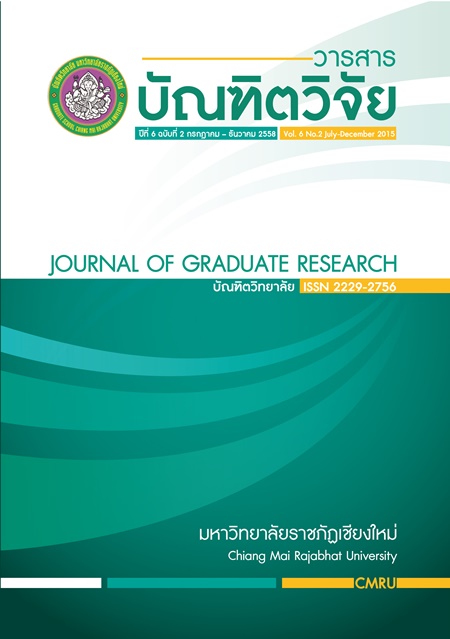Diagnostic Test Development by Using Cognitive Diagnostic Model
Main Article Content
Abstract
DIAGNOSTIC TEST DEVELOPMENT BY USING COGNITIVE DIAGNOSTIC MODEL.
New trend of test construction for diagnosis of students’ strength and weakness was developed. It was named “Cognitive Diagnosis Model.” (CDM). from the past two decades a lot of articles were printed, various mathematical models were proposed. But in Thai academic atmosphere, there were very few articles mentioned this progression, so in this article concepts about CDM were presented, it consisted of Q-matrix idea, various models about CDM which were the DINA Model, the G-DINA Model, the RUM model, and the AHM Model. After that the author presented some ideas about the goodness and some obstructions of CDA. Finally it was suggested that now it was the best opportunity for Thai scholars to take part in the research about this topics for both academic progression and the development of Thai education.
Downloads
Article Details
References
De la Torre J. (2011). The Generalized DINA Model Framework. Psychometrika, 76(2), 179 – 199.
De Carlo, L. T. (2011). On the Analysis of Fraction Subtraction Data: The DINA Model, Classification, Latent Class Sizes, and the Q-Matrix. Applied Psychological Measurement, 35(1), 8-26.
Di Bello, L.A., & Stout, W.F. (2010). Arpeggio Documentation and Analyst Manual. [Computer Software Version 3.1.003.] Applied Informative Assessment Research Enterprises.
Di Bello, L.V., Roussos, L.A. & Stout, W.F. (2007). Review of Cognitively Diagnosis Assessment and a Summary of Psychometric Models. Handbook of Statistics, 26, 1-52.
Gierl, M.J.; Leighton, J.P., & Hunka, S. (2007). Using the Attribute Hierarchical Methodto Make Diagnostic Inferences About Examinees’ Cognitive Skills, In Leighton, J.P. and Gierl, M.J. (Eds.). Cognitive Diagnostic Assessment for Education: Theory and Applications. (pp. 242-274). Cambridge, UK : Cambridge University Press.
Gu, Z. (2011), ‘Maximizing the Potential of Multiple-Choice Items for Cognitive Diagnostic Assessment’, Unpublished doctoral dissertation. University of Toronto. สืบค้นจาก https://tspace.library.utoronto.ca/ bitstream/1807/31770/1/Gu_Zhimei_201111_PhD_thesis.pdf
Haertel, E. (1984), ‘An Application of Latent Class Models to Assessment Data’, Applied Psychological Measurement, Vol. 8, no. 3, pp. 333-346.
Li, H. (2011), ‘A Cognitive Diagnosis Analysis of the MELAB Reading Test. Span Fellow Working Papers in Second or Foreign Language Assessment’, Vol. 9, pp. 17- 46. สืบค้นจาก https://www.cambridgemichigan.org/Sites/default/files/
resources/SpaanPapers/Spaan v9Li.pdf
Leighton, J.P., Gierl, M.J. and Hunka, S.M. (2004), ‘The Attribute Hierarchy Method for Cognitive Assessment : A Variation on Tatsuoka’s Rule-Space Approach’, Journal of Educational Measurement, 41(3), 205-237.
Roussos, L.A., Templin, J.L. and Henson, R.A. (2007), ‘Skills Diagnosis Using IRT-Based Latent Class Models’, Journal of Educational Measurement, 44(4), 293-311.
Roussos, L.A., DiBello,L.V., Stout, W., Hartz, S.M., Henson, R.A. and Templin, J.L. (2007). The Fusion Models Skills Diagnosis System’, In Leighton,J.P. and Gierl, M.J. (Eds.) Cognitive diagnosis assessment for education : Theory and Applications. (pp. 275-318). Cambridge, UK: Cambridge University Press.
Su, Y. (2013), Cognitive Diagnostic Analysis using Hierarchically Structured Skills. Unpublished doctoral dissertation. University of IOWA. สืบค้นจาก https://ir.uiowa.edu/cgi/viewcontent.cgi?article=4769&context=etd
Tatsuoka, K.K. (1983). Rule Space: An Approach for Dealing with Misconceptions Based on Item Response Theory. Journal of Educational Measurement, 20(4), 345-354.
Tatsuoka, K.K. (1985). A Probabilistic Model for Diagnosing Misconceptions by the Pattern Classification Approach. Journal of Educational Statistics. Vol. 10, no. 1, pp. 55-73.
Tatsuoka, K.K. and Tatsuoka, M.M. (1992), ‘A Psychometrically Sound Cognitive Diagnosis Model: Effect of Remedial As Empirical Validity. Princeton, New Jersey: Educational Testing Service. สืบค้นจาก https://dtic.mil/dtic/tr/fulltest/u2/a255926.pdf


